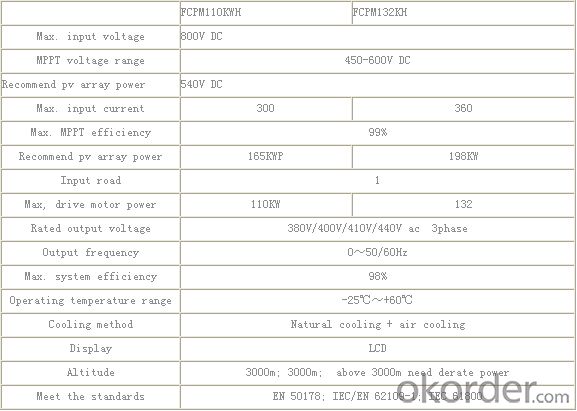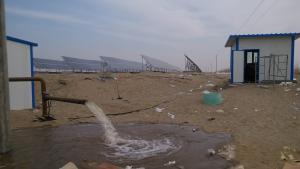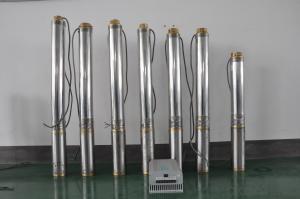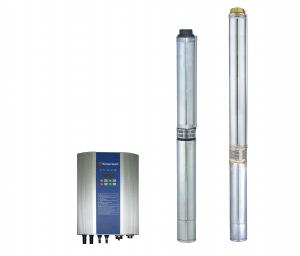Solar pump inverter FCPM110KH
- Loading Port:
- China Main Port
- Payment Terms:
- TT OR LC
- Min Order Qty:
- -
- Supply Capability:
- -
OKorder Service Pledge
Quality Product, Order Online Tracking, Timely Delivery
OKorder Financial Service
Credit Rating, Credit Services, Credit Purchasing
You Might Also Like
Solar pump inverter FCPM110KH Product Description:
Solar water pumping system is constructed with solar panel array,solar pump inverter and AC water pump, DC current produced from solar panel will be delivered to solar pump inverter,and it will convert it into AC current to drive water pump,and will automatically regulate output frequency according to sun radiance intensity,maximally realize MPPT tracking function.
Features
Adopting the proposed dynamic VI maximum power point tracking (MPPT) control method, with fast response, and reliable operation, achieves efficiency of 99%.
Designed with variable frequency driver, greatly improves efficiency
Extremely high efficiency
Digital mode control, with automatic operation and manual operation mode options
Complete protection functions
Adopts intelligent IPM module, with high reliability
LCD display and operation panel, in real time presents operating data
Optional for water level measurement and control circuit
Applicable for general ACC pumps, like centrifugal pump, piston pump etc.
Independent intellectual property; Highly effective, the redundant reliability, exempts the maintenance and the long life.
The pumps are soft started, fully protected.
No batteries are used. So better Sunlight, more water.
Datasheet.

- Q:How does the angle or tilt of the solar panels affect the performance of a solar pump?
- The angle or tilt of the solar panels plays a crucial role in determining the performance of a solar pump. The angle at which the panels are installed affects their ability to capture sunlight efficiently and convert it into electricity. Ideally, solar panels should be tilted at an angle that maximizes their exposure to sunlight throughout the day. The optimal angle differs depending on the geographical location of the installation and the time of year. For example, in the northern hemisphere, the panels should be tilted at an angle equal to the latitude of the location for maximum solar energy absorption during the summer months. Similarly, during the winter months, adjusting the tilt angle to a steeper angle allows the panels to capture sunlight more directly when the sun is lower on the horizon. If the panels are not properly tilted, their surface area exposed to sunlight may be reduced, resulting in decreased energy generation. A lower tilt angle may cause the panels to receive less direct sunlight, leading to a lower efficiency in converting sunlight into electricity. On the other hand, a steeper tilt angle may increase the amount of direct sunlight absorbed, but it can also lead to potential shading issues if nearby objects obstruct the panels. Therefore, finding the optimal tilt angle for solar panels is essential to ensure the highest possible performance of a solar pump. Regular monitoring and adjustment of the panel tilt angle can help maximize energy production and optimize the system's overall efficiency.
- Q:Can a solar pump be used for geothermal heating and cooling?
- Geothermal heating and cooling systems rely on the earth's core for their heat source, whereas solar pumps are not equipped to tap into this geothermal energy. Solar pumps are designed to use solar energy for powering various applications, but they are not specifically designed for geothermal purposes. While solar energy can be utilized in certain components of a geothermal system, it cannot substitute the essential geothermal heat exchange process that these systems depend on.
- Q:Booster pump installed in the solar water heater, the correct location should be where the solar water heater?
- if it is The general pump is indeed a lot of noise. Or look at the pump is not the air. Control mode is not activated by the flow switch.
- Q:How does the angle and orientation of solar panels affect the performance of a solar pump?
- The angle and orientation of solar panels have a significant impact on the performance of a solar pump. The angle refers to the tilt of the solar panels, while the orientation refers to the direction they face. The angle at which solar panels are installed affects their efficiency by determining the amount of sunlight they receive. Solar panels work by converting sunlight into electricity, and the angle at which they are tilted determines the amount of sunlight they can capture. The optimal angle depends on the geographical location of the solar pump. For example, in regions near the equator, a flat or low tilt angle is preferable to maximize the exposure to the sun throughout the year. In contrast, in higher latitudes, a steeper tilt angle is recommended to compensate for the lower intensity of sunlight. The orientation of solar panels refers to the direction they face, typically either towards the south or north depending on the hemisphere. In the Northern Hemisphere, for instance, solar panels should face south to capture the maximum amount of sunlight. By facing south, solar panels can receive sunlight for the longest duration during the day. Similarly, in the Southern Hemisphere, solar panels should face north for optimal performance. The angle and orientation of solar panels also impact the efficiency of a solar pump by influencing the angle of incidence, which is the angle at which sunlight strikes the surface of the panels. When sunlight strikes the panels at a perpendicular angle, it is most efficiently converted into electricity. If the angle of incidence is too high or too low, the efficiency of the solar panels decreases. Adjusting the tilt angle and orientation helps to optimize the angle of incidence, thus maximizing the energy output of the solar pump. Overall, the angle and orientation of solar panels are crucial factors in determining the performance of a solar pump. By adjusting these parameters according to the geographical location, it is possible to optimize the capture of sunlight and maximize the efficiency of the solar pump.
- Q:Can a solar pump work at night?
- No, a solar pump cannot work at night because it relies on sunlight to generate the necessary power to operate. Solar pumps use photovoltaic panels to convert sunlight into electricity, which is then used to power the pump. Without sunlight, there is no source of energy for the pump to function. However, some solar pumps may have the capability to store excess energy generated during the day in batteries, which can then be used to power the pump at night or during cloudy days. These batteries act as a backup power source when sunlight is not available.
- Q:What is the impact of a solar pump on wildlife conservation?
- The impact of a solar pump on wildlife conservation can be significant. By providing a sustainable source of water in remote areas, solar pumps can help create and restore habitats for various wildlife species. Access to clean water supports the survival and reproduction of animals, enabling them to thrive and maintain healthy populations. Additionally, solar pumps reduce the need for human intervention in traditional watering methods, minimizing disturbances to wildlife and their habitats. Overall, solar pumps contribute to the conservation of wildlife by promoting ecosystem balance and enhancing biodiversity.
- Q:Are there any noise concerns with a solar pump?
- No, there are no noise concerns with a solar pump as they operate silently, without the need for any noisy motors or engines.
- Q:Can a solar pump be used for water supply in military camps or bases?
- Yes, a solar pump can definitely be used for water supply in military camps or bases. Solar pumps are reliable and efficient, utilizing solar energy to power water pumping systems. They can be easily deployed in remote locations, providing a sustainable and cost-effective solution for water supply in military operations. Additionally, solar pumps require minimal maintenance and have a long lifespan, making them suitable for the demanding conditions of military camps or bases.
- Q:Are there any limitations on the maximum height or elevation that a solar pump can pump water?
- Yes, there are limitations on the maximum height or elevation that a solar pump can pump water. The maximum height is determined by factors such as the power and efficiency of the solar pump, the size and capacity of the solar panels, as well as the length and diameter of the water pipes. It is important to consider these factors and select a solar pump that is suitable for the required pumping height or elevation.
- Q:Are there any specific installation requirements for a solar pump in a well?
- Yes, there are specific installation requirements for a solar pump in a well. These requirements include ensuring proper sizing of the pump to match the well's water output, positioning the solar panels at an optimal angle and orientation to maximize sunlight exposure, and using suitable wiring and controls for the system. Additionally, it is important to ensure proper well casing and sealing to prevent any contamination of the well water.
1. Manufacturer Overview |
|
|---|---|
| Location | |
| Year Established | |
| Annual Output Value | |
| Main Markets | |
| Company Certifications | |
2. Manufacturer Certificates |
|
|---|---|
| a) Certification Name | |
| Range | |
| Reference | |
| Validity Period | |
3. Manufacturer Capability |
|
|---|---|
| a)Trade Capacity | |
| Nearest Port | |
| Export Percentage | |
| No.of Employees in Trade Department | |
| Language Spoken: | |
| b)Factory Information | |
| Factory Size: | |
| No. of Production Lines | |
| Contract Manufacturing | |
| Product Price Range | |
Send your message to us
Solar pump inverter FCPM110KH
- Loading Port:
- China Main Port
- Payment Terms:
- TT OR LC
- Min Order Qty:
- -
- Supply Capability:
- -
OKorder Service Pledge
Quality Product, Order Online Tracking, Timely Delivery
OKorder Financial Service
Credit Rating, Credit Services, Credit Purchasing
Similar products
New products
Hot products
Hot Searches
Related keywords





























